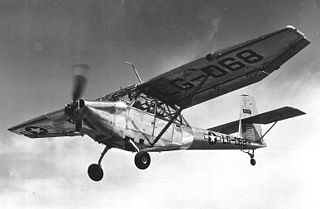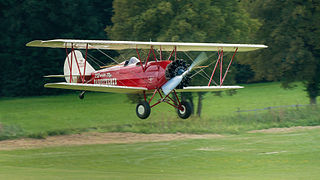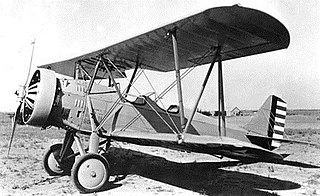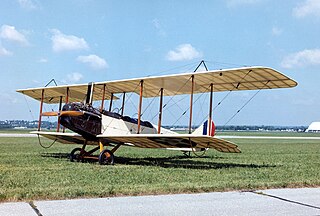
The Stinson L-13 was a US military utility aircraft first flown in 1945.

The Curtiss Robin, introduced in 1928, was a high-wing monoplane built by the Curtiss-Robertson Airplane Manufacturing Company. The J-1 version was flown by Wrongway Corrigan who crossed the Atlantic after being refused permission.

The Bell 47 is a single-rotor single-engine light helicopter manufactured by Bell Helicopter. It was based on the third Bell 30 prototype, which was the company's first helicopter designed by Arthur M. Young. The 47 became the first helicopter certified for civilian use on 8 March 1946. The first civilian delivery was made on 31 December 1946 to Helicopter Air Transport. More than 5,600 Bell 47s were produced, including those under license by Agusta in Italy, Kawasaki Heavy Industries in Japan, and Westland Aircraft in the United Kingdom. The Bell 47J Ranger is a modified version with a fully enclosed cabin and tail boom.
The 1911 Curtiss Model D was an early United States pusher aircraft with the engine and propeller behind the pilot's seat. It was among the first aircraft in the world to be built in any quantity, during an era of trial-and-error development and equally important parallel technical development in internal combustion engine technologies.

The Aeronca L-3 series of liaison aircraft was used by the United States Army Air Corps in World War II. The L-3 was adapted from Aeronca's pre-war Tandem Trainer and Chief models.
The Alexander Eaglerock was a biplane produced in the United States in the 1920s by Alexander Aircraft Company of Colorado Springs, Colorado.

The Interstate Cadet was an American two-seat tandem, high wing, single-engine monoplane light aircraft. Around 320 of these aircraft were produced between the years 1941 and 1942 by the Interstate Aircraft and Engineering Corporation based in El Segundo, California. The construction techniques employed were a welded steel tube fuselage, wood (spruce) wing structure with metal ribs, and fabric covering, all of which were fairly standard in the 1940s.
The Aeronca Model 9 Arrow was a low-wing all-metal cabin monoplane with retractable landing gear. It was marketed to returning pilots from World War II and unveiled in 1947 but never went into production.

The Franklin O-200 was an American air-cooled aircraft engine of the early 1940s. The engine was of four-cylinder, horizontally-opposed layout and displaced 200 cu in (3 L). The power output ranged between 65 hp (48 kW) and 100 hp (75 kW) depending on variant. The O-200-5 (4ACG-199) featured a geared propeller drive.

The Culver PQ-14 Cadet is a modified version of the Culver LFA Cadet used as a target drone.

The Commonwealth Skyranger, first produced as the Rearwin Skyranger, was the last design of Rearwin Aircraft before the company was purchased by a new owner and renamed Commonwealth Aircraft. It was a side-by-side, two-seat, high-wing taildragger.

The Travel Air 6000 is a six-seat utility aircraft manufactured in the United States in the late 1920s.

The Travel Air 2000/3000/4000 (originally, the Model A, Model B and Model BH were open-cockpit biplane aircraft produced in the United States in the late 1920s by the Travel Air Manufacturing Company. During the period from 1924–1929, Travel Air produced more aircraft than any other American manufacturer, including over 1,000 biplanes. While an exact number is almost impossible to ascertain due to the number of conversions and rebuilds, some estimates for Travel Air as a whole range from 1,200 to nearly 2,000 aircraft.

The Meyers OTW was a 1930s United States training biplane designed by Allen Meyers and built by his Meyers Aircraft Company from 1936 to 1944.

The Stearman Model 6 Cloudboy was a 1930s American training biplane designed and built by the Stearman Aircraft Company of Wichita, Kansas.

The Standard J is a two-seat basic trainer two-bay biplane produced in the United States from 1916 to 1918, powered by a four-cylinder inline Hall-Scott A-7a engine. It was constructed from wood with wire bracing and fabric covering. The J-1 was built as a stopgap to supplement the Curtiss JN-4 in production.

The Historic Aircraft Restoration Museum, located at Creve Coeur Airport in Maryland Heights, Missouri, United States, is dedicated to restoring and preserving historical aircraft. The airplanes in the collection are all fabric-covered, and most are biplanes from the inter-war years. The museum's volunteers maintain most of these aircraft in full working order. This is one of the largest collections of flying classic aircraft in America.
The Airpower Museum is a 20,000-square-foot (1,900 m2) aviation museum located near Blakesburg, Iowa on Antique Airfield. The Airpower Museum was founded by Robert L. Taylor and the Antique Airplane Association in 1965 and features various periods of aviation through models, engines, propellers, photos and original art. Approximately 25 aircraft are on display, including warbirds from World War II.

The Culver Aircraft Company was an American aircraft manufacturer of light aircraft of the 1930s and 1940s.

The Aeronca K series, Aeronca Chief, Aeronca Super Chief, Aeronca Tandem, Aeronca Scout, Aeronca Sea Scout, Aeronca Champion and Aeronca Defender were a family of American high-winged light touring aircraft, designed and built starting in the late 1930s by Aeronca Aircraft.



















